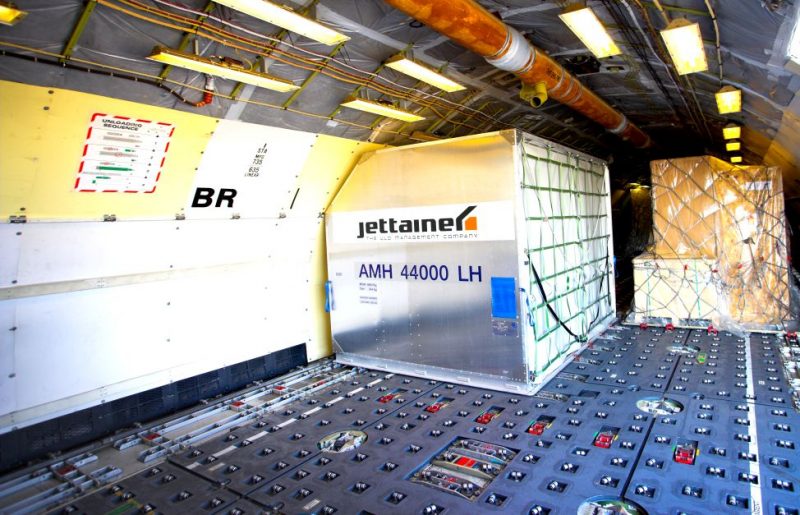ULDs: Keeping cargo together
ULDs are certified and tested to maximum load limits, the freight is restrained with a net, and/or straps and securely locked in place on the aircraft, so it cannot move or shift.
Using unit load devices (ULDs), commonly divided into pallets and containers, is a normal scenario in the cargo export industry for companies handling goods transported to various places.
It’s the most effective way to handle and store materials and make loading and unloading an easy task, ensuring that your products arrive safely to their destination.
The unit load device market is projected to grow from $1.64 billion in 2016 to $2.02 billion by 2021, at 4.28% CAGR during the forecast period, according to markets and markets.
Air Cargo Update met with cargo industry experts from Jettainer, Emirates, Etihad Airways and Cargolux to go in depth as to how ULDs help in storing, managing and delivering cargo in one go to its final destination.
David Dubois, Cargolux’s Head of Global ULD Services, notes, “It makes things easier. A pallet plus net helps secure several smaller pieces of cargo—ready to load onto an aircraft in a safe and efficient manner. Offsize cargo that is larger than the pallet’s dimension can be loaded on a combination of pallets rather than a container.”
“Pallets help to organize cargo for air transport. By pre-arranging the cargo items on pallets load control, the weight is equally spread within the plane, the conture/shape is strictly adhered to, so the loading process is timely and efficient, all items are secured according to official rules and regulations (one needs to be certified to ‘built’ a pallet, meaning to secure items on a pallet and cargo can be placed on pallets prior to the flight, saving time,” notes Jettainer’s marketing and PR head Martin Kraemer.
Cargo transportation
ULDs are used to load freight and mail on wide-body aircraft. It allows a large quantity of cargo to be bundled into a single unit. It saves ground time and effort which helps to reduce the turnaround time of flights. Each ULD has a tag with details of cargo loaded on it and the contents, which are listed in the cargo manifest for the flight, helps to track the cargo.
David Kerr, Senior Vice President, Etihad Airways, said, “Pallets help to organize cargo for air transport. Palletised products can be moved more quickly than manually handling individual cartons. Palletised products can be moved more efficiently and stored more efficiently in warehouses. Pallets are typically easier to handle with material handling equipment than other styles of unit load device. Cargo can be placed on pallets prior to the flight, saving time compared to bulk loading.”
Specific requirements
The selection of ULD for loading is based on the specification of cargo. There are different ULDs like VRA/VZA for cars, HMA for horses, RKN for temperature controlled cargo such as pharma.
“Yes, there are several types of ULDs required for many different types of cargo, i.e. TSC pharma in active container, horse stall, heavy cargo on a heavy duty pallet. Special container hold garments on hangers, lockable doors container are used for valuables or carracks. As a specialized cargo airline, Cargolux offers the right ULDs for all customer requirements,”says Cargolux’s David Dubois.
Emirates SkyCargo has a fleet of cool dollies that are used to transport temperature sensitive pharmaceutical products from ramp to temperature controlled storage area and vice versa.
It is also used as a temporary temperature controlled storage unit at ramp for quick transfer of pharma cargo. The cool dolly can support temperature ranges between -20C and +20C.
Emirates SkyCargo also has maindeck cool dollies that can transport temperature sensitive cargo to and from the storage area to the aircraft for quick loading and unloading.
“Our product development team also invented a new cool container which we named ‘White Container’. It is coated on the inside with thermal Insulators to counteract high temperatures in Dubai and help preserve temperature-sensitive cargo, including fruits and vegetables as well as pharmaceuticals.
“The latest innovative product in our suite of transportation solutions for perishables, the Emirates SkyFresh Ventilated Cool Dolly not only maintains a constant temperature while transporting cargo, but also has a ventilation system that allows it to bring in fresh air from outside. The fresh air is then cleaned using custom built filters, cooled and then circulated inside the refrigerated interior where the temperature sensitive perishable cargo is stored. This is also available in a maindeck version,” says an Emirates spokesperson who declined to be named.
Safe and Secure
ULDs are certified and tested to maximum load limits, the freight is restrained with a net, and/or straps and securely locked in place on the aircraft, so it cannot move or shift. Containers have solid lockable doors.
“Containers protect cargo from all types of weather and give better protection against the damage of cargo. Cargo that cannot fit into containers are loaded onto pallets and secured with straps and nets to fasten the load, ensuring the cargo cannot shift during the flight. The ULD itself is locked on the ground of the aircraft with fasteners so it will be physically linked to the plane and not shift during the flight,” said, David Kerr of Etihad Airways.
“As cargo is stored in them/on them according to official rules and nets/ straps are used to fasten the load, it is thus made sure no cargo can shift during the flight.
The ULD itself is locked on the ground of the planes cargo or main deck with fasteners, so the ULD will be physically linked to the plane and can not shift during the flight,” said Jettainer’s Martin Kraemer.
Quick cargo movement
ULDs are pre-loaded, so they are ready anytime. They also hold a number of pieces of cargo that can all be handled in one go. They are crucial in transporting air cargo safely, quickly and cost-effectively.
They enable individual pieces of cargo, luggage or mail to be assembled into a single unit, which can then be loaded on and off an aircraft with speed.
To prevent the ULDs moving around during flight and potentially damaging the aircraft, the plane has loading and restraint systems. These interface directly with a ULD, locking it into place so it becomes part of the aircraft.
Loading capacity
On a PMC (96x125in) – the most common ULD – the maximum weight is 6.8T, on a heavy duty device, i.e. 20ft pallets (96×238.5in), cargo up to 29T can be loaded with restrainers on the aircraft and depending on the position in the aircraft .A main deck container can be loaded just like a PMC, 6.8T.
Pallets and containers can be loaded up to 3m high with a contour that fits the aircraft, according to Cargolux
ULD comparison
At times pallets are more preferred than containers as they are cheaper compared to containers for cargo transportation. Pallets can accommodate cargo that is difficult to fit into containers (e.g. oversized cargo). They are stackable and therefore efficient and easy to store empty and return by aircraft.
On the logistic side, pallets are easier to move and re-position than containers.
However, according to Jettainer there are cargo items that perfectly fit on pallets, and others better in containers. Baggage for example always flies containerized.
It is the nature of the goods and/or the preference of the airline what ULD they use. E.g. it is more difficult to steal from a container than form a pallet.
Handling requirements
“ULDs become part of the aircraft the moment they are locked on the aircraft floor. Therefore, they always must be in excellent serviceable condition, handled with care and should be ‘airworthy’, and there are strict rules regarding airworthiness.
“At Etihad Cargo, we provide ‘Serviceability training’ to all staff who handle the ULDs. There is pocket guide called ‘Damage Limitation Card’ provided for their easy reference,” says Kerr.
“We have training in place for GHAs and will introduce it for forwarders handling Cargolux ULDs. ULD requires special and careful handling in order to keep them serviceable and prevent damage to the cargo. Our specialists use advanced procedures during handling and pallets and containers are regularly maintained to keep them in top shape,” according to Cargolux’s spokesperson.
Jettainer has a program called ULD-X-perts, teaching handling staff of the right way to treat ULDs. This is done in order to lower repair incidents.
Precautionary measures
Pallets are to be covered with polythene covers to protect from weather conditions like rain, dust etc. They are to be stored in appropriate locations depending on the conditions and type of cargo loaded on the pallets.
ULDs need to carry the owner’s name in order to know where to bring them or who to contact in case of abundance units.
Mandatory markings on ULDs include IATA code and TSO/ETSO plate, manufacturer’s data plate, ODLN (operational damage limitation notice- used to check ULD for serviceability). A ULD tag is attached with the AWB number that is unique to that ULD and allows to track the cargo linked to that ULD.
ULDs must be moved on dollies only – from the time they are loaded until they are secured on a position on the aircraft.
There are also constant develo-pments and advances in technology as well, testing is continuous (RFID, GPS) but generally, controlling is done with manual input of ULD messages processed by an IT system.
Also it is IMPORTANT to note that it is not the decision to use or not use a pallet. It is GIVEN by the type of airplane that the needed ULDs (containers or pallets. If a plane is equipped with a roller bed, freight HAS TO be loaded on ULDs only. Most planes (belly and freighter) are using ULDs, according to pallets expert Jettainer.
Jettainer always labels ULDs in addition to the Jettainer sign with an airline denominator and the airline code of its customer. This is as Jettainer runs INDIVIDUAL ULD fleets for each single customer.
Jettainer adds a ULD number for individual tracking, tracing and steering of each ULD. This number is unique making it possible to steer any single ULD within our network.
There is as well a QR code on the ULD for electronic recognition. This, together with the unique number and the airline code & Logo is ALL NOT MANDATORY.



















